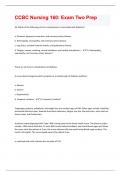CCBC Nursing 160: Exam Two Prep
34. Which of the following chronic complications is associated with diabetes?
a. Dizziness, dyspnea on exertion, and coronary artery disease.
b. Retinopathy, neuropathy, and coronary artery disease.
c. Leg ulcers, cerebral ischemic events, and pulmonary infarcts.
d. Fatigue, nausea, vomiting, muscle weakness, and cardiac arrhythmia's. - ✔✔*b. Retinopathy,
neuropathy, and coronary artery disease.*
These are all chronic complications of diabetes.
A nurse shoud recognize which symptom as a cardinal sign of diabetes mellitus?
a. Nausea
b. Seizure
c. Hyperactivity
d. Frequent urination - ✔✔*d. Frequent Urination*
Polyphagia, polyuria, polydipsia, and weight loss are cardinal signs of DM. Other signs include irritability,
shortened attention span, lowered frustration tolerance, fatigue, dry skin, blurred vision, sores that are
slow to heal, and flushed skin.
A patient newly diagnosed with Type I DM is being seen by the home health nurse. The doctors orders
include: 1200 calorie ADA diet, 15 units NPH insulin before breakfast, and check blood sugar qid. When
the nurse visits the patient at 5 pm, the nurse observes the man performing blood sugar analysis. The
result is 50 mg/dL. The nurse would expect the patient to be
a. confused with cold, clammy skin an pulse of 110.
,b. lethargic with hot, dry skin and rapid deep respirations.
c. alert and cooperative with BP of 130/80 and respirations of 12.
d. short of breath, with distended neck veins and bounding pulse of 96. - ✔✔*a. confused with cold,
clammy skin an pulse of 110.*
Signs and symptoms indicative of hypoglycemia.
A patient recovering from DKA asks the nurse how acidosis occurs. The best response by the nurse is
that:
a. insufficient insulin leads to cellular starvation, and as cells rupture they release organic acids into the
blood.
b. when an insulin deficit causes hyperglycemia, then proteins are deaminated by the liver, causing
acidic by-products.
c. excess glucose in the blood is metabolized by the liver into acetone, which is acidic.
d. an insulin deficit promotes metabolism of fat stores, which produces large amounts of acidic ketones.
- ✔✔*d. an insulin deficit promotes metabolism of fat stores, which produces large amounts of acidic
ketones.*
Rationale: Ketoacidosis is caused by the breakdown of fat stores when glucose is not available for
intracellular metabolism. The other responses are inaccurate.
A patient screened for diabetes at a clinic has a fasting plasma glucose level of 120 mg/dl (6.7 mmol/L).
The nurse will plan to teach the patient about:
a. use of low doses of regular insulin.
b. self-monitoring of blood glucose.
,c. oral hypoglycemic medications.
d. maintenance of a healthy weight. - ✔✔*d. maintenance of a healthy weight.*
Rationale: The patient's impaired fasting glucose indicates pre-diabetes and the patient should be
counseled about LIFESTYLE CHANGES to prevent the development of Type 2 diabetes.
The patient with pre-diabetes does not require insulin or the oral hypoglycemics for glucose control and
does not need to self-monitor blood glucose.
A patient with type 1 diabetes has received diet instruction as part of the treatment plan. The nurse
determines a need for additional instruction when the patient says,
a. "I may have an occasional alcoholic drink if I include it in my meal plan."
b. "I will need a bedtime snack because I take an evening dose of NPH insulin."
c. "I will eat meals as scheduled, even if I am not hungry, to prevent hypoglycemia."
d. "I may eat whatever I want, as long as I use enough insulin to cover the calories." - ✔✔*d. "I may eat
whatever I want, as long as I use enough insulin to cover the calories."*
Rationale: Most patients with Type 1 diabetes need to plan diet choices very carefully.
Patients who are using intensified insulin therapy have considerable flexibility in diet choices but still
should restrict dietary intake of items such as fat, protein, and alcohol.
The other patient statements are correct and indicate good understanding of the diet instruction.
Again, how is Type 1 DM managed if they do not produce any insulin? - ✔✔Insulin is required for them
to survive!
They have to do SMBG (self-managed blood glucose), nutritional therapy, and exercise.
, Again, what is a Hemoglobin A1C or Glycated Hemoglobin level? - ✔✔It's a blood test that reflects the
average blood glucose over a 2-3 month period.
Again, what is the normal range for *fasting* blood glucose? - ✔✔60 - 110 mg/dL
Again, what is the normal range for Hemoglobin A1C and what does this test show? - ✔✔The normal
range is 7.0% or less and this test is the average blood glucose over the course of 3 months.
Alright last one, time to talk about VERY long acting or Basal insulins! Unlike Intermediate insulin these
do not have a protein derivative in them to make them cloudy, so these are clear and usually given at
bedtime. Can very long acting insulin be mixed with other types of insulin? - ✔✔NOOOOOO!
Long acting CANNOT be mixed with any other insulin!
Any HgbA1C level greater than 7.0% is considered out of control, but what if the level rises to 10-12%? -
✔✔Then the patient's BG is completely out of control and they WILL develop complications.
Are CAM interventions such as herbs effective for Hyperthyroidism? - ✔✔They might not hurt, but if a
goiter is already present that ship has sailed---they will then need medical intervention.
Blood sugar is well controlled when Hemoglobin A1C is:
a. Below 7%
b. Between 12%-15%
c. Less than 180 mg/dL
d. Between 90 and 130 mg/dL - ✔✔*a. Below 7%*
A1C measures the percentage of hemoglobin that is glycated and determines average blood glucose
during the 2 to 3 months prior to testing. Used as a diagnostic tool, A1C levels of 6.5% or higher on two
tests indicate diabetes. A1C of 6% to 6.5% is considered pre-diabetes.




